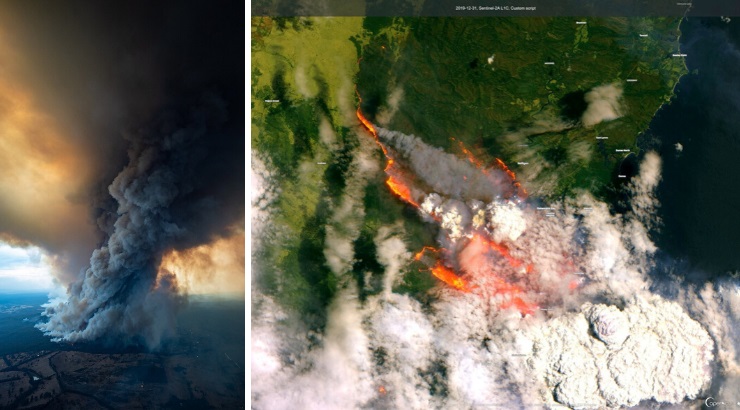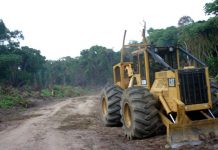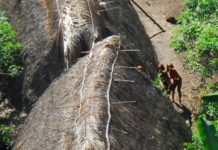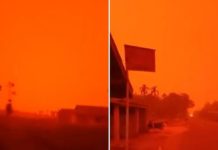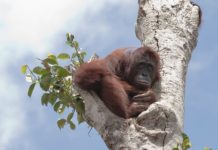As Australia’s horrific bushfire crisis continues unabated, smoke plumes believed to cover an area greater than that of Europe have been created while glaciers in neighboring New Zealand have been turned black by soot from the fires.
In the meantime, nearly 500,000,000 animals have been killed while the human death toll has climbed to at least 17. Experts have warned of a broader humanitarian crisis looming over the country, fueling anger at the government of Prime Minister Scott Morrison.
On Wednesday, experts noted that a massive plume of smoke spanning roughly 2.1 million square miles (5.5 million sq km) had begun drifting over the Pacific Ocean toward New Zealand, which BBC reports has been blanketed in smoke and haze from the Australia fires in recent days. The Guardian reports that vacationers have described the hazy skies in New Zealand as “sepia,” “orange” and “apocalyptic.”
Antti Lipponen, a research scientist at the Finnish Meteorological Institute, wrote in a tweet that the smoke plume is well over four times the size of Alaska, 14 times the size of Japan, and roughly equal to the distance between Iceland and Turkey.
The area of the smoke plume from #Australia fires is now almost 7.3 million sq. km! SuomiNPP / VIIRS satellite image.#NASAWorldview: https://t.co/YoqEhScJnU pic.twitter.com/psKlQiTJjR
— Antti Lipponen (@anttilip) January 2, 2020
The smoke and soot have even stained New Zealand’s iconic white glaciers, turning them black and “caramelizing” the snow in a process that could further endanger glaciers already threatened by climate change. Former New Zealand Prime Minister Helen Clark wrote in a tweet that the impact of Australian ash on glaciers “is likely to accelerate melting.”
Snow and ice usually reflect the sun’s heat and slows melting while white. However, snow blackened by ash and dust rapidly absorbs heat and therefore melts at faster rates.
Huge smoke plume showing up on GOES-17 from the Australia fires.
Currently being wrapped up by a low pressure system over the Pacific. pic.twitter.com/OUwk0I4E8P
— Dakota Smith (@weatherdak) January 2, 2020
The environmental calamity has been stoked by a combination of extreme winds, record-shattering heat waves, and drought-parched forests, grasslands, and brush. Australia’s bushfires have also grown so monstrous that they are generating their own weather in the form of pyro-cumulonimbus clouds—or thunderstorms that create more fires—according to Victoria’s Bureau of Meteorology.
Weather forecasts have predicted continued withering hot conditions and fierce winds across southern Australia on Friday as well as dangerous bushfire conditions in eastern Victoria and New South Wales (NSW) on Saturday. Thousand of firefighters, including huge numbers of volunteers, have been fighting the over 100 fires in NSW and over 40 in Victoria.
Near Franz Josef glacier. The “caramelised” snow is caused by dust from the bushfires. It was white yesterday pic.twitter.com/Ryqq685Ind
— Fabulousmonster (@Rachelhatesit) December 31, 2019
The nightmarish nature of the crisis took a new form over the weekend as 4,000 people in the coastal town of Mallacoota, Victoria, fled to the shore and even into the water as the blaze threatened to consume their homes.
Tourist Kai Kirschbaum told ABC Australia:
“I think that was our biggest threat in terms of what are we doing with the children if we need to go in the water to protect ourselves given the fact that they are only 1, 3 and 5.
If you’re a good swimmer it doesn’t really matter if you have to be in the water for a longer time, but doing that with three kids that would have been, I think, a nightmare.”
In the meantime, ecologists are fearing a tremendous tragedy for wildlife as nearly 500 million mammals, reptiles and birds—including 8,000 koalas—are estimated to have been killed. The massive loss of life threatens to forever tip the balance for entire species of animals and plants.
Over 300 baby flying foxes were abandoned by their mothers who were trying to survive by any means, according to experts.
Australia’s bushland is home to a range of indigenous fauna such as kangaroos, koalas, wallabies and possums. Authorities have no exact figure on how many native animals have been killed in the bushfires but experts say it is likely to be in the millions https://t.co/NXoEkxAlxP pic.twitter.com/yP2VUYBLeS
— Reuters (@Reuters) December 30, 2019
Wildlife rescuer Jenny Packwood told the Sydney Morning Herald:
“Mothers are abandoning babies at two weeks after birth because there is no food for them. Last week we had 300 come in, and we’ve been flat out feeding since then.
I’ve never seen anything like this before—we’re calling it a starvation event.”
Species like bats also face the threat of local extinction from the massive obliteration of small creatures such as insects in wildfire-impacted regions, thre Independent reported.
Koala Crisis wrote on Facebook:
“Not one carer KC has spoken to has seen bees, insects, grubs, worms, snails, beetles, millipedes, for months. Nothing struggles through the dustbowls which are now covering millions of hectares in all states.
There’s no grass for the ’roos, no insects for the birds, the leaves on eucalypts are brittle, ensuring starvation for koalas, gliders, possums, birds, insects.”
The bushfires devastating Australia have been raging since September, laying waste to wildlife and private property alike. Experts are fearing that a humanitarian crisis is imminent as the country faces the worst fire season in recorded history with three more months of the summer season left.
Along with the fires, arid conditions due to a prolonged drought have wrought devastation on the livelihoods of farmers and local economies.
The Australian government, headed by Prime Minister Scott Morrison, has been accused of denying the realities of climate change despite its belated verbal acknowledgment that changing climate conditions have played a role in the crisis. The government has been accused of obstructing global summits on climate change and skirting its obligations under the 2015 Paris accord while doing little to curtail the country’s role as the world’s number one exporter of coal and liquefied natural gas.
Australians’ anger toward the prime minister—who has derisively been nicknamed “ScoMo” or “Scummo”—was abundantly clear Thursday when he was forced to scrap a meet-and-greet with locals in a fire-scourged NSW town. As the beleaguered prime minister attempted to reassure residents, locals showered abuse on him.
The Guardian quoted residents cursing Morrison as “an idiot,” telling him that he’s “not welcome” and should “piss off” and not expect any future votes.
Scott Morrison forcing this woman to shake his hand, then ignoring her and walking away when she tells him she doesn’t want a handshake unless he gives more funding to the RFS, is fucking disgusting – even by his low standards. #bushfiresAustralia #auspol pic.twitter.com/LX6agg3S7G
— Brendan Bradford (@1bbradfo) January 2, 2020
By Elias Marat | Creative Commons | TheMindUnleashed.com
Bushfires Australia: how you can donate and help the volunteer firefighters
Donating directly
The NSW Rural Fire Service has multiple options for direct donations. You can donate to the RFS as a whole, or to specific brigades. You can donate through bank transfer, credit card or cheque.
For bank transfers, there is a set bank account (Account Name: NSW Rural Fire Service, BSB: 032-001, Account No: 171051). This account is for the RFS as a whole.
For credit cards, this link will take you to the landing page. You can choose specific brigades from a dropdown box, or donate to the RFS general fund.
And if your brigade is not listed, or if you are unclear, you can contact your local brigade.
In Queensland, Fire and Rescue advise that you can donate both money and items through the website givit.org.au.
The website allows fire-affected communities to list what they specifically need, from water tanks in Yeppoon to school uniforms in Zillmere.
In Victoria, the Country Fire Authority has two bank accounts, one for specific brigades and one for the general fund.
In South Australia, the Country Fire Service accepts donations through the CFS Foundation. You can donate to them here. You can also leave a bequest.
Holding a fundraiser
You can also hold a fundraiser for the fire authorities, or donate to a fundraiser.
However, the NSW RFS advises that you should donate only to verified fundraisers. That’s also true for those setting up fundraisers – get authorisation from the RFS first.
“It’s important that fundraising activities are conducted in a way that is transparent and aligns with the values of the NSW RFS,” they told Guardian Australia.
To hold a fundraising event, you should email them at [email protected].
You’ll also need to provide information on your group, how you will raise funds and what portion will be donated, and the specifics of any item being sold or donated.
“The NSW RFS may place restrictions on the use of its insignia (which includes its name, logo or imagery) for legal reasons, and any use of the insignia must be expressly approved,” a spokesperson said.
“So that the community can be assured that fundraising is legitimate, unless undertaken by NSW RFS brigades members, the service does not support fundraising activities that solicit donations from members of the public beyond members within your registered business, group or association.”
The RFS said it had been flooded with requests to hold fundraisers, so it might take some time to respond.
The Victoria CFA also has a fundraising kit here, with information on how to host one.
Enquiries can be directed to [email protected] or 1800 232 233.
Helping the recovery
What about for areas that no longer have active fires, but have been hard hit? There are a range of ways to help.
You can donate to some of the charities who routinely help with recovery: the Red Cross Relief and Recovery Appeal, St Vincent de Paul or the Salvation Army.
You can also donate, provide items or volunteer at specific evacuation centres – a list can be found here. In general it is always better to give money to the charities that organise assistance, rather than donating in kind, unless there is a specific request for certain items, or if you have checked in advance what may be required.
Each centre may have different needs, so it is important not to arrive unannounced with goods to donate.
On Friday, for example, one evacuation centre for the Green Wattle Creek fire said it did not need donations. Craig Madsen, the general manager of the Mittagong RSL, paid tribute to the work of the charities.
“At the moment, we’re coping quite well,” he told Guardian Australia. “Yesterday was a little hectic but the Red Cross, Salvation Army and disaster assistance people rolled in, got everything organised quite well. The people who came in were looked after.”
Madsen said the RSL had been supplying evacuees with its own food, at its own cost, and waved away donations.
“We haven’t set up any formal donation points here at the club at this stage, we are great for food,” he said. “No real issues for that at this stage.
“The people that came through, we just supplied them at the club.”
Volunteering
Queensland Fire and Rescue also advice that you can volunteer your time to the bushfire effort.
“The best way you can help is to check on the safety of your loved ones, neighbours and friends and help them however you can,” it says.
You can also formally register as a volunteer at Emergency Volunteering. You can also call Volunteering Queensland on 1800 994 100.
